External filters for the aquarium: design, selection and installation
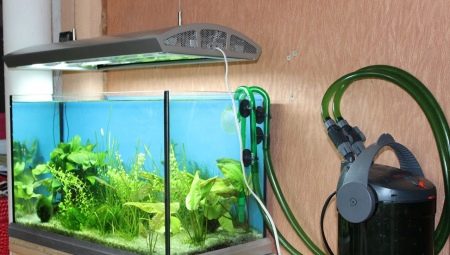
The success of aquarium fish breeding largely depends on the quality of the equipment used. An obligatory attribute of a professional aquarium nowadays is an external or internal filter, which is responsible for biological and mechanical water purification. This article will discuss the correct choice of one specific purification device, namely: an external (external) filter.
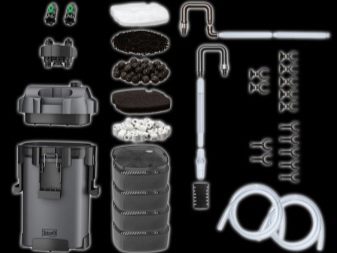
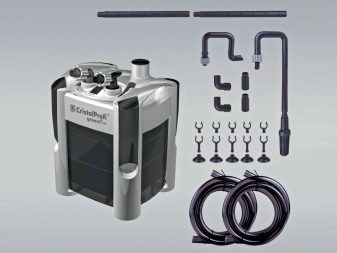
Description and working principle
An external filter (also called a canister filter) for an aquarium is one of the most efficient filtering devices. By means of it you can operate aquariums with a capacity of 40-1500 liters.
It is already clear from the name that the device is placed not inside the aquarium, but outside it - near the bedside table or directly in it. Only the intake and outlet tubes are lowered into the aquarium with water.
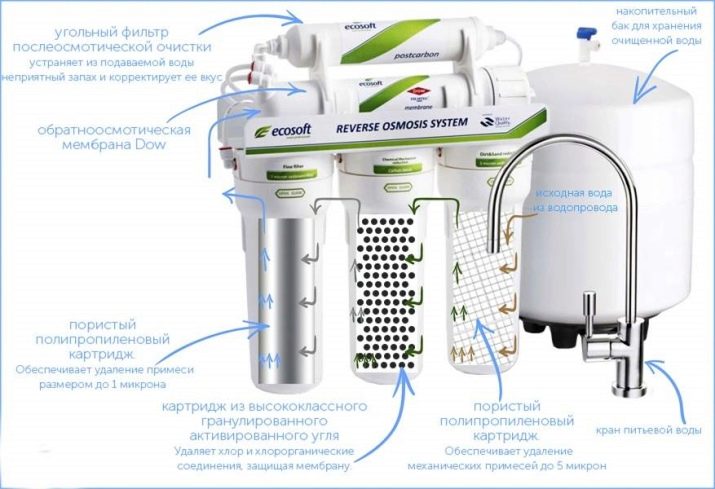
Canister filter compartments
Almost always, according to their own main focus, external filters are composite. They have several departments:
- compartment for mechanical cleaning, where the sponge or synthetic winterizer is located, which stop dirt particles;
- biological material department - microorganisms participating in the processing of organic substances to a state harmless to the inhabitants of the aquatic environment;
- compartment for chemical cleaning with hygroscopic material, which can be quartz, activated carbon or zeolite.
Based on your needs, you can change the basic filling of the external cleaning system.
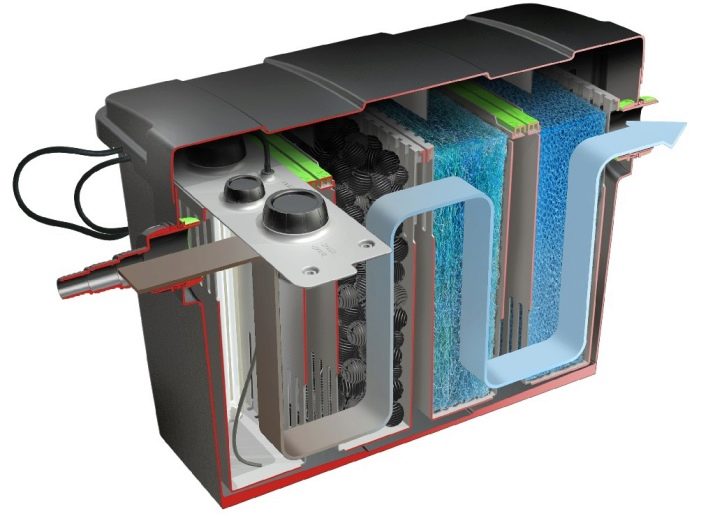
Device device
The basis of the filtering apparatus is stably a pump that brings the water located in the system into activity. Typically, pumps are located in the upper area of external filters, and filter media for chemical, mechanical and biological treatment are located in a large reservoir, called a "flask", below them.
Several tubes are taken from the flask (mainly two, in the samples for large containers - 3), mating with the intake and supply tubes. At the tip of the intake tube there is either a pre-filter or a safety net.
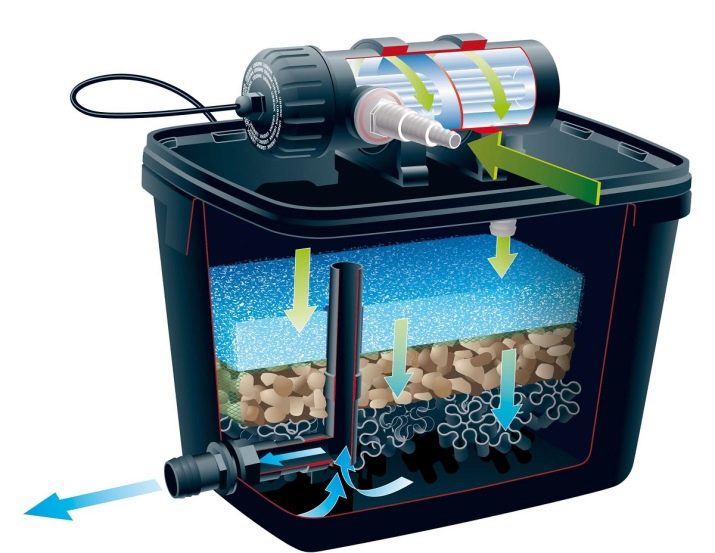
At the tip of the feed tube, there is either a "flute" or a narrow nozzle.
Let's consider the principle of operation of an external filtering device.
Through the intake tube, the liquid medium from the aquarium through the tube enters the filter, is pumped into the tank (canister) by means of a pump, passes several layers of different cleaning material and again through the hose, already clean, enters the aquarium back into the aquarium. The structure of the canister cleaning device, based on the brand and manufacturer's modification, is different - the liquid medium can flow from top to bottom or back.
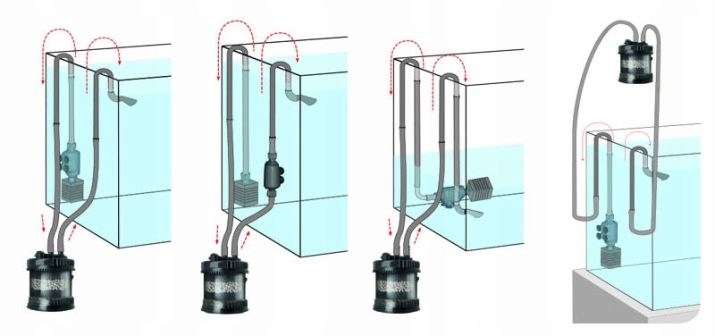
How do they differ from internal ones?
The difference between external and internal filtering devices is as follows:
- a colossal amount of filtering materials when compared with internal devices;
- usually higher throughput than internal filters;
- as mentioned above, multilevel filtration - in particular, the filter package includes fillers for biological (bio-fillers), mechanical (sponges) and chemical (zeolite or activated carbon) purification;
- as a result of the above, much finer water purification;
- the external device needs attention much less often than the internal device - mostly not more often than once every 2-3 months.
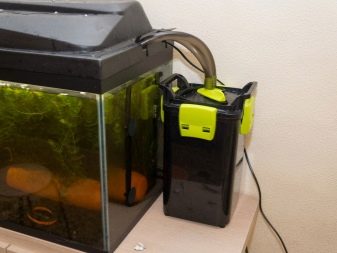
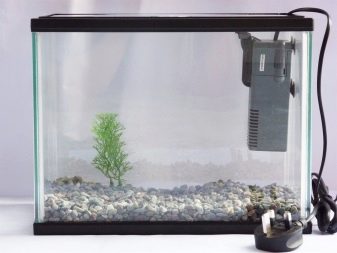
Some extreme lovers do not clean the filter even for 6-12 months, but it is better to look there more often.
Experienced aquarists recommend purchasing external filter, since in terms of the totality of its properties, it is significantly ahead of its inner companion.
What are the fillers?
The canister filter, due to its own structure, makes it possible to form a multi-stage water purification in the aquarium.
For the mechanical method of purifying liquids in apparatuses, it is practiced sponges of different density and cellularity... The fine-pored sponge is able to stop the smallest particles of dirt. They also use a synthetic winterizer to purify water from the smallest particles of dirt.

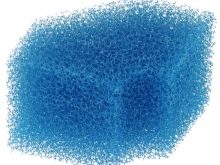
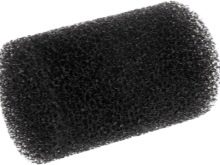
There is a huge amount of filtering materials for biofiltration - these are rings, ceramic balls, and similar materials. Sometimes expanded clay is used as a filtering material in handicraft outdoor units. They usually have a porous structure, their main purpose is to provide the cleaning microorganisms with a space for colonization, this requirement is necessary for the effective functioning of the external filter.
There are also ceramic rings with a smooth surface without pores, the purpose of such a material is to divide the water flow entering the device in order to create conditions for optimal, measured distribution over the entire surface of the cleaning material.
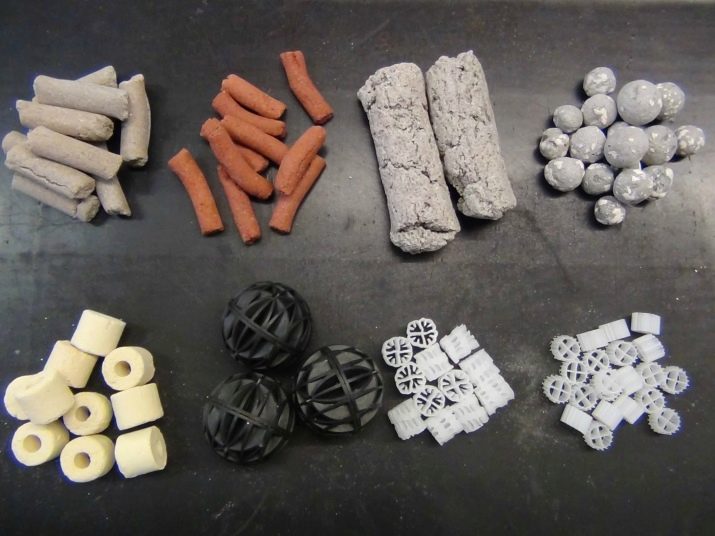
It is desirable to place such a substrate in the first compartment of the apparatus.
Chemical cleaning is carried out using fillers such as zeolites, activated carbon (active) and synthetic organic ion exchangers. Active carbon has a very porous microstructure, due to which it perfectly adsorbs (absorbs) acids, toxic substances and microelements. For the most part, activated carbon is used in filtering devices after treating fish in an aquarium in order to remove traces of medications from the water.
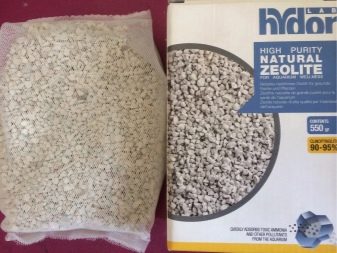
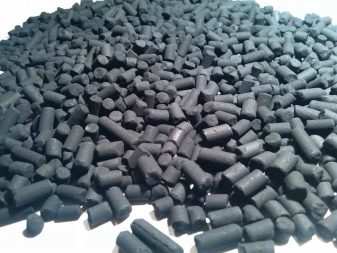
Rating of the best models
Let's consider the most popular filter models for outdoor aquariums.
Filters for 50-100 liters
The Tetra EX600 Plus is designed for small aquariums of 60-120 liters. One of the most popular filtering devices on the domestic market. It functions stably (manufacturer's warranty - 3 years) and is almost inaudible. Each of the five litters is in an individual tray. For cleaning, it is instantly disconnected using a specialized adapter.
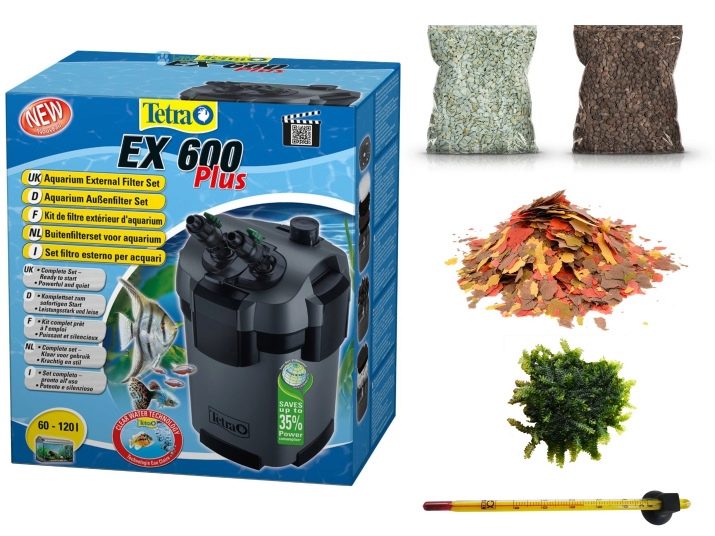
The drain hoses and tube can be adjusted to suit different aquarium heights. The composition contains everything you need for a comfortable and quick installation, including all cleaning materials.
JBL CristalProfi e401 (up to 120 l) is a convenient and moderately inexpensive greenline device. The water is cleaned by slowly passing from bottom to top through the fillers. The modernized pump impeller ensures absolute quietness and a long service life (the manufacturer guarantees - 4 years). The device is completely ready for use, equipped with all fillers.

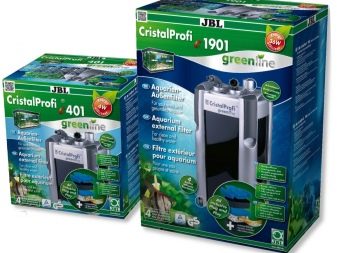
Apparatus for 120-300 liters
Eheim 2215 Classic-350 for 120-350 l tanks. Eheim Classic Series the most affordable of the entire Eheim product line... Despite the seeming simplicity of installation, it carries out high-quality cleaning inherent in all models. The complete set contains fillers: substrates, sponges and the like. The warranty period is 2 years.

The Tetra EX800 Plus is suitable for 100-300 L tanks. A rugged and affordable external device, powerful and incredibly quiet. Complete with everything necessary for assembly, installation and start-up of the system.
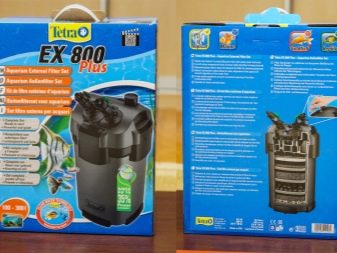
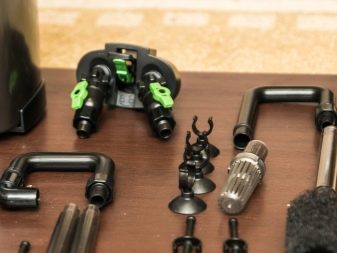
300 or more liters
JBL CristalProfi e1501 (up to 600 l) is a highly productive and moderately inexpensive greenline device. Suitable for both fresh and sea water aquariums. The convenient location of the fillers greatly simplifies maintenance. The equipment is absolutely ready to use, all fillings are included in the kit.
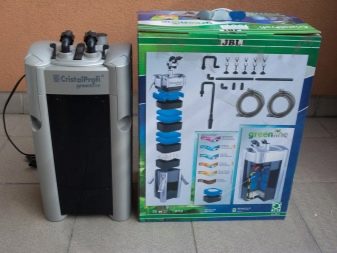
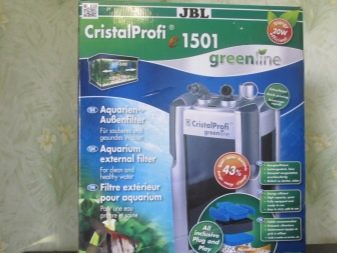
Aquael Unimax 500 is used for vessels with a capacity of 250-500 liters. The Unimax series is a combination of high productivity, large amounts of fillers and competitive cost. The bypass system makes it possible to remove the canister for flushing without disconnecting the hoses. The device is provided with two inlets and two outlets, which contributes to uniform cleaning of the entire reservoir.
Functions extremely quiet. It is possible to supplement the system with an ultraviolet sterilizer (a workplace is provided for it). The warranty period is 2 years.
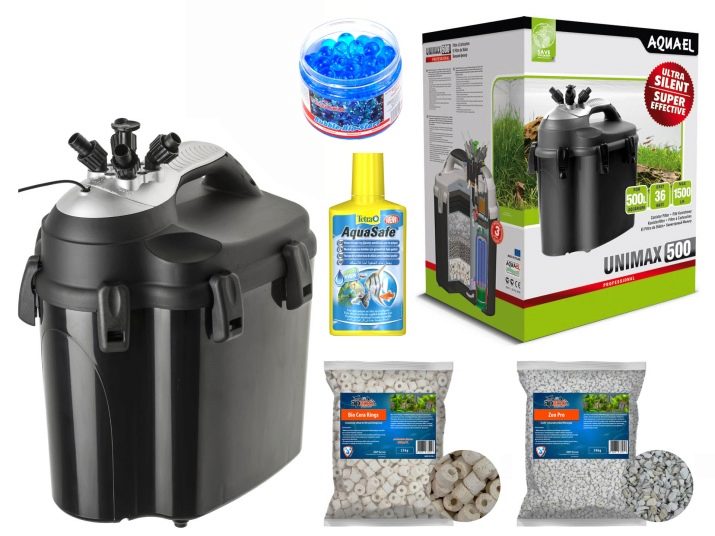
Attention! Aeration also plays a very important role in enriching the aquarium water with oxygen. For a tank with a capacity of 100-150 liters, the Aquael APR-150 compressor is ideal.
How to choose?
An external filter is simply a must for large aquariums. When buying a model, one should take into account not only the quality of the apparatus and the capacity of the aquarium, but also the practicality of its use.
For many aquarists, the main repulsive reason in the unit is noise, so pay close attention to this.
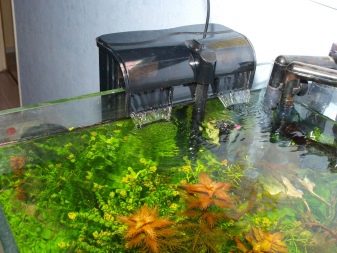
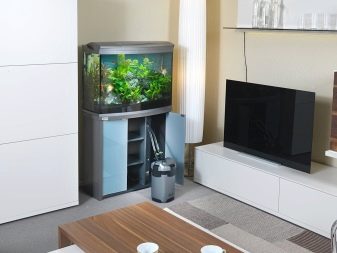
The selection instructions include several nuances.
- Of course, the external device is mounted outside the aquarium, therefore it is necessary to plan the space for it ahead of time. Before purchasing, the first thing you need to know is how much power your device should have. It directly depends on the capacity of the aquarium.
- If you have a small aquarium, pay more attention to the quality and noise indicators, since the power requirements of the filter device are not too high. Study the manufacturer's advice in detail, the capacity of your tank should be slightly less than the recommended standards, otherwise the device may not cope with its work. If you have a very populated aquarium, then take into account how densely populated it is. It happens that there are a lot of inhabitants, then you need to buy a filter with a good power reserve.
- For aquariums with a small capacity of 30 to 70 l, the external filter should have a capacity of 300 to 400 l / h.This should be sufficient when the aquarium is fairly densely populated.
- If we analyze another category of aquariums with a capacity of 60-100 liters, the productivity of the apparatus should be higher. Roughly for this category, it is equal to 500 l / h.
- For larger aquariums, the performance should of course be higher. In particular, for a capacity of 100 to 200 liters, it is approximately equal to 700 liters / hour. The choice of outdoor units is extensive, so it will not be a problem to choose the modification that suits you.
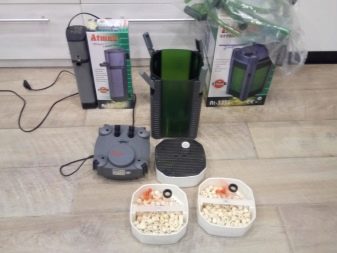
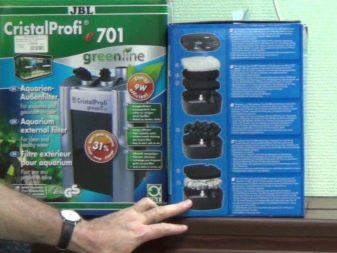
How to install?
Each manufacturer has its own installation features, but there is a universal method.
- Prepare a soft pad and a few rags in case of a leak.
- Carefully examine the contents of the box: it should contain internal sponges, the device itself, fillers, plastic water outlets.
- Adhere to the manufacturer's practice guidelines when assembling the filter. The valves on the cover open at the end of the process. The filler, according to the rules, is laid in this way: ceramics or bio balls on the very bottom, sponges on them, followed by a synthetic winterizer, the final upper layer is coal or peat.
- Prepare elements for the intake and release of water: a long rounded tube sucks in water, a short curved one throws it out, it is placed at the other end of the aquarium. Calculate in advance the size of the hoses to be sufficient.
- Before starting the device, fill it with gravity water from the aquarium (for this purpose, connect the intake hose with a threaded clamp). Water will pour out as soon as you open the tap. Be careful not to let water flow from the other hole. After the device is completely filled, close the intake hose.
- Connect the discharge hose to the appliance, close it, then pour water into the unoccupied end and connect to the plastic outlet.
- Final action: unscrew both taps on the device, and connect the system to the socket.
If everything is done correctly, it will be noticeable how the water begins to mix.
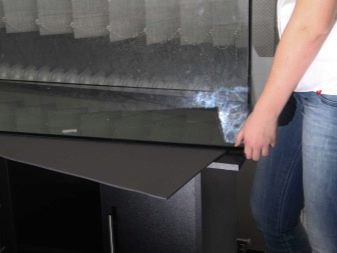
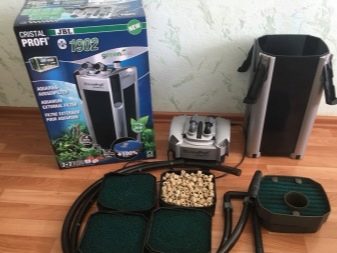
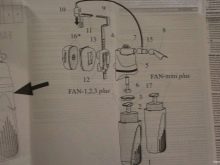
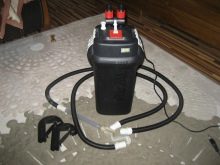
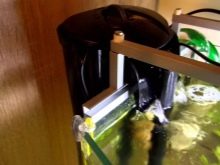
Complications appear from time to time - the liquid medium does not run. The problem is an air lock in the tubes of the filter device.
You need to turn it on and off several times in a row. If this fails, drain the water and refill the hoses.
Subtleties of operation
The canister filter works according to a specific principle. Until beneficial microorganisms colonize the filter material, the device functions essentially as a mechanical one. It gradually becomes dirty, as a result of which the water pressure decreases. But there is also an opposite process.
Dirt is food for microorganisms. They decompose the organic compounds accumulating here and process them into nitrates, in other words, the biological self-purification of the device starts. Complex colonization of the substrate by groups of beneficial microorganisms is carried out in 2-4 weeks.
And then everything depends on which of the processes will win - pollution or self-cleaning.
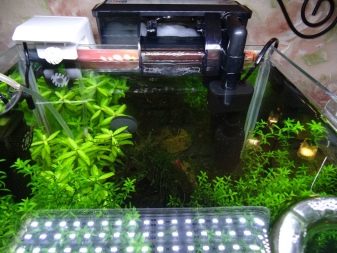
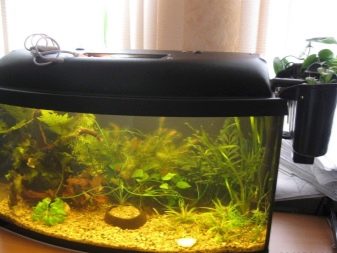
If the former, the device will continue to clog up. Not as intense as the first 2 weeks, but inevitable, especially if the water intake is not protected by a pre-filter.
As soon as the throughput of the device drops below 30% of the highest, it needs to be cleaned and restarted, otherwise a "rollover" may occur. But if, nevertheless, self-cleaning takes over, then the device, on the contrary, is gradually cleared of contaminants, and, having dropped to 50-70% of the maximum performance, is revived.
In theory, after such a filter should function indefinitely. In practice, productivity is not fully reproduced, and stagnant areas still appear inside the filter. In this regard, it should be cleaned on occasion, even when the fluid pressure is strong.
Most aquarists believe that since the main purpose of the external filtering device is biofiltration, there is no need to overload this device with mechanical cleaning.
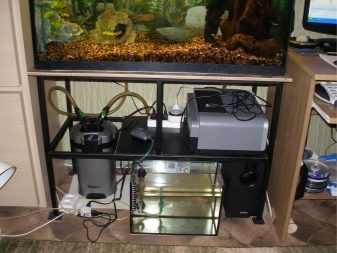
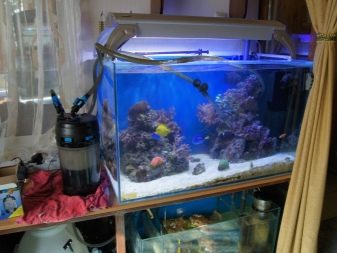
For this purpose, it is advisable to use an internal filter, which must be constantly washed.
Is it possible and necessary to turn off the external device when feeding the fish and when changing the water? No. It is preferable that it is constantly functioning.
- Thus, it will last longer, since the maximum load on electricity and mechanisms occurs during the start-up period (this is like light bulbs that most often burn out just when the lighting is turned on).
- There is a danger that the aquarist will be distracted by something, will forget to start the device back at the end of the event, and after that it will stay turned off for a long time.
Therefore, the water intake must be located at the bottom of the aquarium, so that when 25-50% of the volume of liquid is pumped out, the device remains working when it is replaced. And under no circumstances should you turn off the device for a long time: at night, for the period of departure, and if something like that happens for some unknown reason, then you need to wash the fillers and restart the device. As noted earlier, for a decently dirty filter device, sometimes 2-3 hours of inactivity can damage the inhabitants of the aquarium.
How to choose an external filter for your aquarium, see below.








